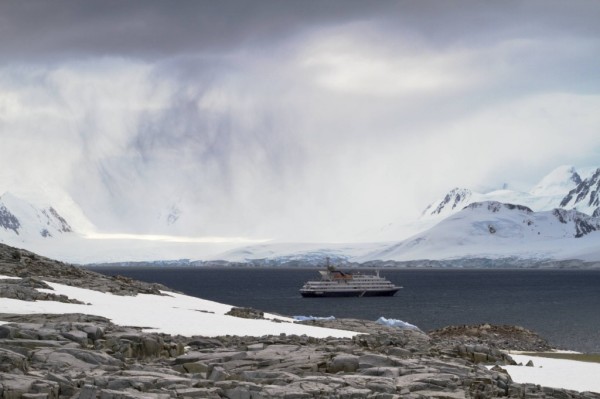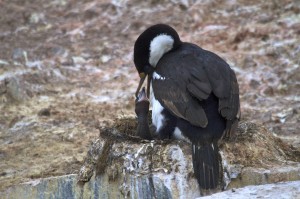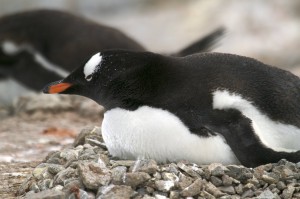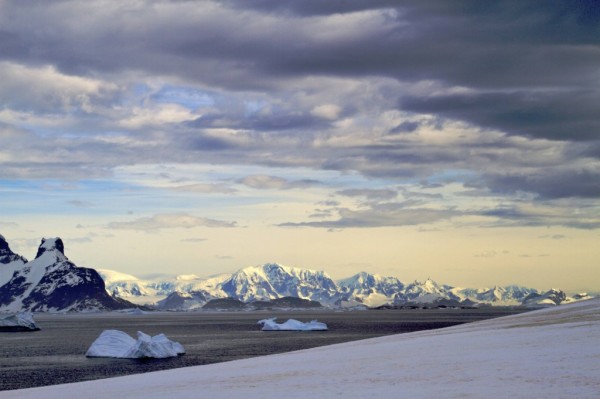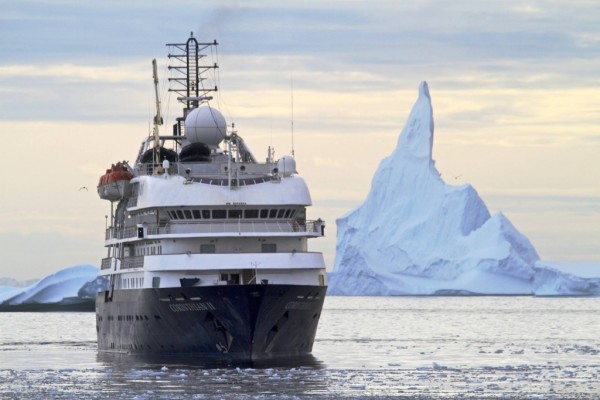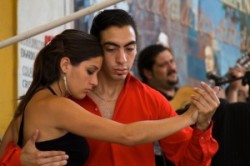We were REALLY going to pack a lot into today, but as is often the case, Mother Nature had other ideas.
Our plans were to do a 6 AM landing in Andvord Bay, but at 5 AM Expedition Leader Susan Adie’s voice came over the ship PA system to announce that the wind had picked up to more than 45 knots (almost 50 mph), so back to bed…
We continued to sail south through the Neumeyer Channel. On each side of the ship, the scenery continued to get more and more stark and rugged – jagged black rock peaks capped with massively thick snowfields, and in the valleys, huge tidewater glaciers.
By late morning we arrived at Weinke Island near Dorian Bay, where the both the Argentines and the British Antarctic Survey had built small huts for the resupply of their respective area research stations. Peter Hillary and some of the other guides took those looking for a hike up a long, snowy hill for a better view of the other side of the island, while most of the rest of us explored a large gentoo penguin colony.
This gentoo colony was being beset by a pair of skuas who were intent on stealing eggs. One of the pair would wander into the thick of the gentoos and draw their ire and pecks, while the other would attack from the other side of the nest, more often that not making off with an egg.
It’s tough being a penguin.
We continued our southward journey, entering the narrow (only 1600 meters across at its narrowest!) but spectacular Lemaire Channel in the early afternoon. At one point we were accompanied by several dwarf minke whales, a subsepcies found in the southern waters.
Our target, and last landing in the Antarctic was Petermann Island, with healthy nesting colonies of blue-eyed shags (cormorants), adelie and gentoo penguins. The late afternoon light was stunning on Mount Scott and the other mountains above the Lemaire. On the west side of the island was a small cove with an iceberg graveyard, where grounded icebergs awaited their inevitable fate.
It was late evening when we headed back north through the Lemaire, retracing our route, and accompanied at a distance by our sister ship, the Corinthian II, who was also on a trip to the Antarctic Peninsula. The skies had cleared a bit and the late evening sun shone on the icebergs and peaks until almost 11 PM. It was hard to stay off the deck and fill up our cameras’ memory cards!
By early morning of December 27, our ship began to pitch and roll heavily as we entered the legendary unprotected waters of the Drake Passage, named for the 16th Century English privateer Sir Francis Drake. The seas boomed against the ship and some washed completely over the bow. Those who hadn’t succumbed to seasickness before in the voyage were now reaching for medication! But by the second day, the waves subsided to a modest couple meters high and we were blessed with an easy passage all the way back into Ushuaia, Argentina.
Our days were filled with more fascinating lectures, including a moving personal account from Peter Hillary about his tragic attempt on the summit of infamous K2.
* * * * * * *
Upon arriving in Ushuaia, we had completed 18 days and some 3504 nautical miles of one of the most treacherous, stormy, isolated, beautiful and biologically unique areas on the planet. The Antarctic and sub-Antarctic region has claimed staggering numbers of ships, lives and dreams over the centuries.
We were so very fortunate to have a modern, comfortable ship in the Clelia II to explore this remarkable region. We relied upon satellites and modern charts for navigation, not astrolabes, sextants or dead reckoning. We had radio and even satellite internet for communications, instead rock cairns with messages inside.
Yet travel in this unforgiving region is not without peril; only a couple of years ago another ship of our size, the M/V Explorer, struck an iceberg and sunk to the sea floor, amazingly sparing all aboard. I had been fortunate some 21 years ago to make my first voyage to Antarctica (on this same itinerary) aboard the Explorer, and some of our crew aboard the Clelia II had actually been aboard the Explorer on her last, ill-fated cruise.
But it’s been characteristic of those who have ventured into this southern realm to return time and again, and I’m glad I’ve been one of them. There are so few places left that are so unchanged, so isolated and so beautiful; in fact, fewer with each passing year.
If you can, go.
–Randy Green–
